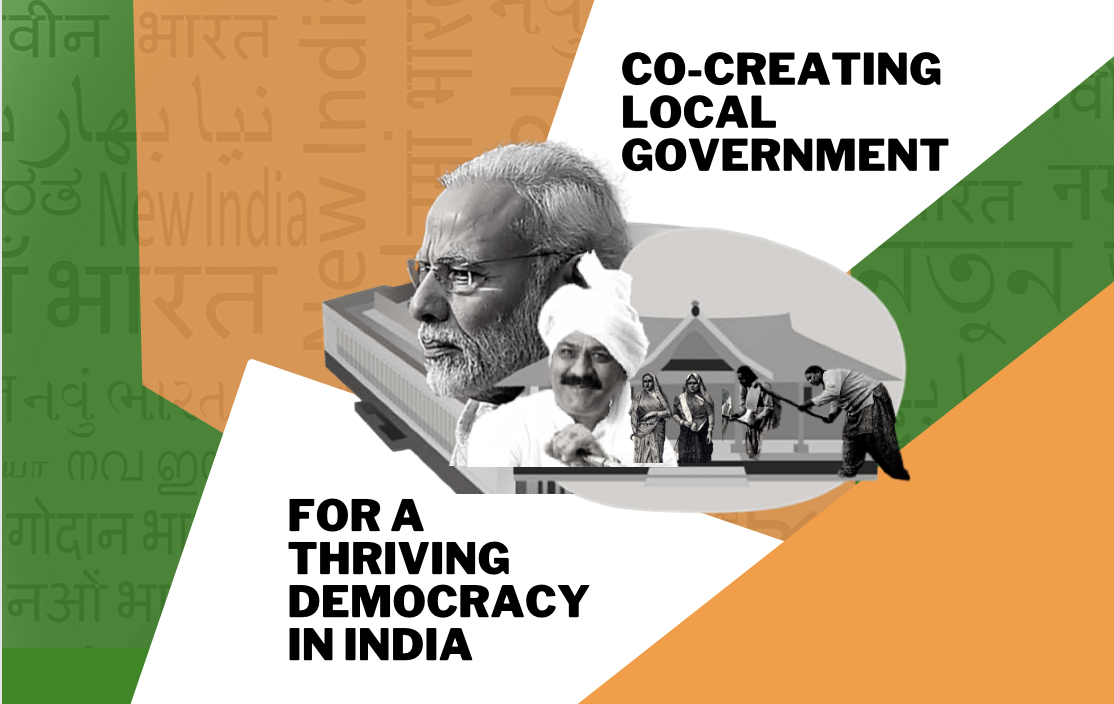Abstract: Witnessing Indian politics, the concept of co-creating local governance is not old-fashioned but has gained notable momentum in recent years. It revolves around fostering active citizen participation, building trust and credibility amongst people and governmental institutions, and enhancing community stewardship at the grassroots level.
A good democracy is one which at the grassroots level embodies a transparent, inclusive, and accountable governance framework. It is where people just like you and I join hands with political leaders and our elected representatives to address local challenges and drive development initiatives in our communities.
This piece delves into the essence of co-creating local governance in India and explores how it can dynamise democracy and rebuild trust in an era of waning faith in government institutions.
Introduction
Puzzle-solving the vibrant narrative of Indian politics, the fabric of local governance has played a pivotal role in the making and shaping of its democratic landscape, completely.
As the world’s largest democracy, India is home to a population of more than 1.4 billion people coming from diverse backgrounds manifold challenges that further imply a demand for innovative approaches to governing that truly reflect the needs and aspirations of its common people.
At the heart of co-creating local governance lies the belief that a thriving democracy like our country must embody key features like transparency, inclusivity, and accountability, particularly at the grassroots level. The idea emphasizes participatory governance, where citizens become active stakeholders in decision-making processes.
This approach moves beyond the traditional top-down framework and empowers communities to identify their needs, propose solutions, and partake actively in decision and policy-making.
Let’s take Pune, for instance, being the 9th largest city in India with a human population of more than 4.3 million had once implemented the ‘Participatory Budgeting’ process, and allowed citizens to share their opinions on aspects as close as land restoration, beautification and development of their region.
According to a recent report by Hindustan Times, this participation has led to a significant influence over the allocation of municipal budgets, laying over Rs. 40 crores for the past term and keeping in mind the preferences and priorities of the locals to date. This collective action of the community alongside the government has proven to foster trust and credibility, as a result of which, residents have been feeling more connected to their local government and have been more likely to participate in community initiatives in the near time.
Another factor in my view to lead a sustainable system of local governance is the strengthening of grassroots institutions. Institutions like the Gram Panchayats and Ward Committees at the grassroots levels play a necessary role in the making and shaping of policies and strategies for a nation as diverse and huge as India.
Institutions like these serve as the foundation for a modern-day democracy, enabling citizens to engage directly with elected representatives and hold them accountable. According to one of recent World Bank reports, the successful implementation of the Mahatma Gandhi National Rural Employment Guarantee Act (MGNREGA) in states like Bihar has served as an epitome of the potential that these institutions bring to the table and change the narrative of empowering rural communities alongside fostering trust in government schemes, completely.
Moreover, considering that we live in the digital age, one cannot ignore how technology plays an important role in enhancing citizen engagement and building credibility within the governance framework. India with its robust system, over 9 years has launched and successfully executed initiatives like MyGov, DigiLocker and many others to provide citizens with a platform to participate in discussion forums, know about their policies and at the same time provide secure access to essential documents and services, respectively.
Additionally, online portals for grievance redressal, like the ‘Swachhata App’ commonly known for its power to report and address sanitation-related complaints has worked to the benefit of the citizens further promoting transparency and responsiveness and enhancing trust in the local government’s ability to address citizens’ concerns.
Co-creating local government involves encouraging community participation in the planning and execution of development projects. This in turn creates an inclusive space which allows the citizens with opportunities to seek opinions from various perspectives and aid in harnessing collective action and community involvement can significantly ensure greater transparency and accountability in the implementation of government programs and result in better outcomes.
In conclusion, I firmly believe co-creating local governance would indeed be a paradigm shift that will hold the potential of re-stitching democracy whilst fostering inclusive decision-making, we can together rebuild immense trust and credibility in an era of scepticism.
Additionally, it gives us both the opportunity and power to involve marginalised people and underrepresented communities in governance in order to make inclusive decisions.
Hence, as young and active citizens, it’s time that we must judiciously engage with elected representatives to strengthen India’s local governance systems and evolve into more transparent, accountable, and citizen-centric models and a source of inspiration for many other countries driving inclusive development and ensuring a thriving democracy for the globe.
References
1. Ansell, C., & Torfing, J. (2021). The Concept of Co-creation: A Genealogy. In Public Governance as Co-creation: A Strategy for Revitalizing the Public Sector and Rejuvenating Democracy (Cambridge Studies in Comparative Public Policy, pp. 33-64). Cambridge: Cambridge University Press. doi:10.1017/9781108765381.002
2. “PMC Citizen Participatory Budget Unutilised for Two Years, Fresh Proposals Invited.” Hindustan Times. Retrieved from: https://www.hindustantimes.com/cities/pune-news/pmc-citizen-participatory-budget-unutilised-for-two-years-fresh-proposals-invited-101627571095998.html
3. Garman, A., Wasserman, H., & Wasserman, H. (2017). Citizens and journalists: The possibilities of co-creating the democracy we want. Media and citizenship: Between marginalisation and participation, 31-51.
4. World Bank Calls NREGA a Stellar Example of Rural Development,” The Economic Times, https://economictimes.indiatimes.com/news/economy/policy/world-bank-calls-nrega-a-stellar-example-of-rural-development/articleshow/23850985.cms.
Feature image provided by author.
